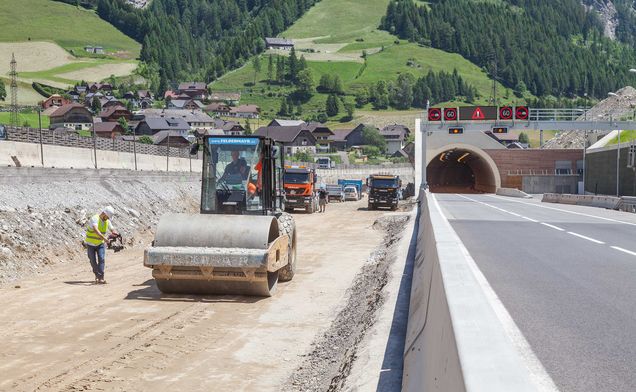No delays in Zederhaus
August 1, 2016 | Markus Lackner
"We started in August 2013, with work to construct three bridge support structures and widen the autobahn," states Felbermayr Construction Manager Thomas Schrodis, recalling the first work to reduce environmental impact and noise in the Zederhaus municipality of Salzburg in Austria. This work was necessary in order to establish culverts for the Zederhausbach stream and to ensure that two lanes are available at all times towards Villach and Salzburg. Subsequent work included demolishing existing culverts and starting work on construction of the tunnel tube in the direction of Villach. The final task is the construction of an enclosure around a 1545 metre (approx.) section of the autobahn. Approximately 900 metres of this section will also be relocated up to 15 metres further away from the Zederhaus municipality and sunk up to 2 metres into the ground.
Fire retardant road surface
Work for the 1545 metre enclosure began with creating the subgrade for the tunnel tube in the direction of Villach. "We laid a 50 centimetre anti-frost layer on top of that, followed by the concrete cover layer with the concrete driving surface," explains Schrodis, pointing out that asphalt is generally not used for the driving surface in tunnels due to the risk of fire. In the case of Zederhaus, the same applies for 100 metres before and after the enclosure.
Joined tube design for the enclosure
In August 2015, structural work in the first tunnel tube was completed as scheduled. This was followed by final completion work with general electrical fitting such as lighting and ventilation. This work was in turn finished in December 2015, and the tunnel tubes were opened for traffic – traffic was redirected and construction work for the second tube could begin. "The work is right on schedule," reports Schrodis happily. And that is despite discovering that deep foundation and surface foundation work was unexpectedly needed for approximately 50 percent of the driving surface in order to improve the ground quality. The second tube was completed in August 2016. This will be followed by creating the road surface and applying a fireproof coating to the inner walls, alongside ongoing sealing measures. Schrodis has this to say on that topic: "We use materials known as bentonite mats for this purpose, which are laid directly against the concrete surface of the enclosure. Plastic sealing is laid in strips over these mats, and is then welded." This work is scheduled for completion by October. After it has been completed, the next task will again be installing operating and safety equipment. "At the end of February, we will start work to cover the enclosure with soil and then plant grass over it. The material required for this originates from the excavation work for the second tube of the Tauern tunnel. It will require around 220,000 cubic metres of soil in total." This is roughly the equivalent of the loading capacity of 20,000 soil trucks. If those trucks were lined up one after the other, they would have a total length of approximately 220 kilometres. The final step is the construction of noise barriers with a length of approximately 400 metres before and after the enclosure. The environmental protection measure for Zederhaus is scheduled to be approved in full by summer 2017.
The largest environmental protection measure
The Zederhaus enclosure is a subproject that was agreed between ASFiNAG, the federal government and the states in 2004. The goal of this joint initiative is to implement environmental protection measures along the A10 Tauern autobahn between Hüttau in Salzburg and Lieserhofen in Carinthia. This project is the largest environmental protection measure along the Tauern Autobahn in Salzburg. For the Zederhaus municipality and its 1200 inhabitants, the implementation of this project means a higher quality of life thanks to reduced noise emissions and more open space thanks to the soil covering the enclosure.







